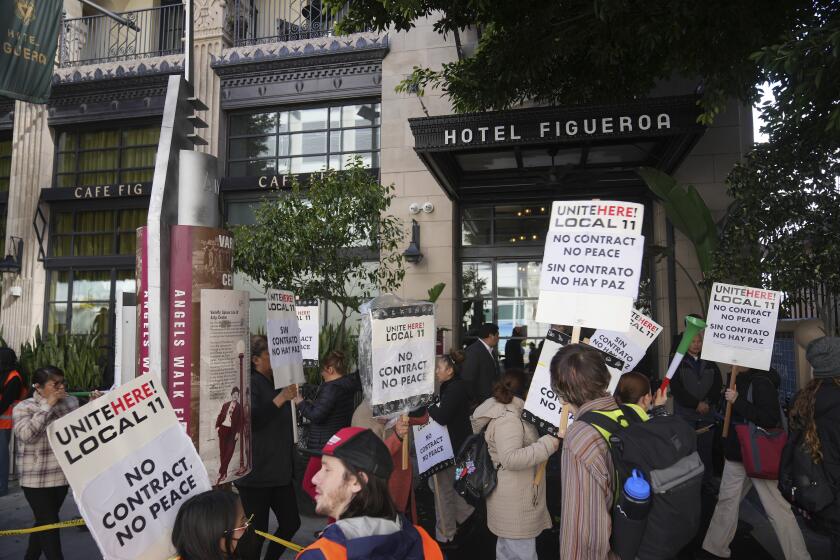Value Stocks May Offer Safer Haven in Turbulent Market
Times of market turmoil are supposed to be times when Wall Street seeks shelter in so-called value stocks--overlooked or otherwise unloved stocks that are relatively cheap when compared with the average stock.
And in this year’s market pullback, value-oriented mutual funds have, in fact, turned out to be somewhat safer havens than their growth stock fund cousins.
Whether that will continue is an open question, but after five years in which value stocks have mostly taken a back seat to growth stocks such as richly valued Microsoft and drug giant Pfizer--many value fund managers believe their day should be here.
“It’s overdue,” said Jean-Marie Eveillard, the value-oriented manager of SoGen International Fund. “It’s long overdue.”
Just what is a “value” stock? Wall Street usually categorizes value and growth stocks according to two key measures:
* The price-to-earnings ratio (P/E), which is the stock’s price divided by the company’s most recent four quarters’ earnings per share, and
* The price-to-book-value ratio (P/B), which is the stock’s price divided by the company’s net asset value per share--that is, the value of the assets minus the company’s liabilities.
In theory, the lower a stock’s P/E and P/B, the lower the risk an investor takes in owning the shares. Hence, the value label.
And in the market decline so far this year, value stock mutual funds have turned out to be lower-risk holdings than growth stock funds, at least on average:
According to mutual fund tracker Morningstar Inc. in Chicago, the average large-cap value fund has fallen 14% since blue-chip shares peaked July 17.
By contrast, the average large-cap growth fund has fallen 16.6%.
The same divergence holds true for small-stock funds, Morningstar figures show.
The average small-cap value fund has fallen 25.4% since the Russell 2,000 small-stock index peaked April 21.
The average small-cap growth fund, meanwhile, has lost 27.5%.
(All of these figures are total returns, which is price change plus dividends.)
This seems to prove Jim Stratton, president of Stratton Capital Management in Plymouth Meeting, Pa., correct.
Notes Stratton: “Value managers tend to underperform in strong up markets and outperform in down markets.”
Still, value funds are trailing growth funds badly for the year-to-date.
The average large-cap value fund is down 2.6% for the year, and the average large-cap growth fund is ahead 6.9%.
And that has been the story for most of the 1990s.
Some analysts argue that value will remain in the doghouse.
Richard Bernstein, market analyst at Merrill Lynch, argues that because corporate profit growth is slowing overall, many investors will be wary of value stocks.
Why?
In times of uncertainty, many investors flock to quality--that is to say, they favor strong companies with proven track records.
Notes Kim Goodwin, manager of the American Century-Twentieth Century Growth Fund: “In times when earnings are hard to come by [such as now], investors are willing to pay a premium for companies that deliver consistent, predictable earnings growth.”
And that favors the fortunes of growth stocks and thus growth funds, she argues.
It’s difficult to say whether this sentiment still prevails, or whether investor psychology has changed.
“Maybe investors are beginning to realize that if we’re going to be in a difficult or bearish market for some time, value exposes [them] to less risk than growth or momentum investing,” said Eveillard.
Exposure to Both Growth and Value
Regardless, Robert Boyd, manager of the UAM ICM Equity value fund, notes that there’s something else working in favor of value managers these days.
The recent market correction has put many of the S&P; 500’s top stocks on sale--stocks that value managers could not touch as recently as a month ago.
Notes Boyd: “We haven’t felt this comfortable buying stocks since the fourth quarter of 1994.”
The argument for value investing now seems strongest within the small-cap universe.
Even if value funds aren’t poised to rally right now, Luke Collins, director of KPMG Peat Marwick’s investment consulting practice, argues that it still “makes sense to invest in value.”
Indeed, take away the last year, and value stocks, going back to Dec. 31, 1974, have actually beaten growth stocks, delivering annualized returns of 17.7% versus 15.3%.
Over the last 15 years, the average value fund that invests in large companies such as Ford Motor Co., which trades at just 2.4 times the company’s earnings per share, has delivered almost exactly the same returns as the typical growth fund--and with decidedly less volatility.
Rather than try to time the market periods in which either growth or value is ahead of the pack, financial planners argue that investors should be exposed to both value and growth stocks at all times.
The simplest way to ensure that your portfolio has exposure to both growth and value stocks is through an index fund, financial planners say.
Yet investors may want to manage this mix themselves. Why?
The best-performing value stocks, it can be argued, are those trading at the deepest discounts based on various measures.
In 1992, for example, University of Chicago professors Eugene Fama and Kenneth French concluded, in part, that stocks trading cheapest relative to their underlying company’s book value are poised to outperform the market.
Last year, the newsletter Dow Theory Forecasts looked at the performance of S&P; 500 stocks based on a different value measure--the better-known price-to-earnings ratio. The newsletter examined the performance of stocks based on their PE ratios as of Nov. 30, 1994.
From Nov. 30, 1994, to May 31, 1997, stocks with PEs below 7 appreciated, on average, 228.3%, the newsletter found. Stocks with PEs of 7 to 10 advanced 100.4%. And the most expensive stocks gained just 57.9%.
(All of these figures are price appreciation alone.)
Unfortunately, index funds don’t necessarily expose investors to the deepest value stocks.
To help identify some true value stock funds, we asked Morningstar to show us two groups of value funds: First, those that have performed best, relative to their peers, over the last 10 years.
Second, we wanted to see which value funds now hold stocks with the lowest average price-to-earnings and price-to-book ratios (again compared with value-fund averages) even if the funds’ performance hasn’t been stellar in recent years.
We used both screens for large-cap and small-cap value funds alike.
The chart accompanying the story shows a mix of value funds that fit one or both screens.
A more detailed look at some of the funds on the list:
Large-Cap Value Funds
* Kemper-Dreman High Return Equity A (5.75% load; minimum initial investment: $1,000): Of the 25 best-performing large-cap value funds over the last 10 years, this $4-billion portfolio represents the deepest value, based on its average holding’s P/E ratio of 16.5.
Manager David Dreman isn’t only a good stock picker, he has a knack for finding promising stocks in beaten-down sectors.
To be sure, his recent bargain-hunting trips into the decimated energy sector have held back the fund’s short-term returns. But not by much.
While the typical value fund has lost 3% over the last 12 months, this fund lost a little less than half as much. Over the last decade, Kemper-Dreman High Return Equity has lived up to its name, delivering annualized returns of 18.3.
* Davis NY Venture A (4.75% load; minimum initial investment: $1,000): Nearly half of this $5.4- billion fund’s assets are invested in the financial sector.
And the fund has paid dearly for it. Since the market peak of July 17, the fund has lost 17.4% versus the 13.8% decline in the S&P; 500.
But have faith. If history is any guide, the fund--now led by Chris Davis, who recently took over for his legendary father, Shelby--will use the opportunity to buy stocks it wanted but could not afford because of its disciplined value approach.
Over the last decade, Davis NY Venture has generated annualized returns of 18.4%, despite being 20% less risky than its peers, according to Morningstar’s risk scoring system.
* Dodge & Cox Stock (no-load; initial minimum: $2,500): Patience is this $4.5-billion fund’s virtue.
Like most value funds, Dodge & Cox Stock seeks big companies with strong balance sheets--including those that recently stumbled.
But what distinguishes this fund from its peers is that it’s willing to wait, often as long as five years or more, for stocks to pick themselves up and turn things around.
For instance, while numerous funds were dumping IBM shares in the early 1990s, when Big Blue shares fell as much as 70% off their 1991 high, Dodge & Cox held on. Smart move.
Over the last 10 years, the fund has delivered annualized returns of 15%.
Yet, it ranks as the 11th-deepest value fund in Morningstar’s large-cap universe, based on its average holding’s low price-to-book ratio of 2.5.
* UAM ICM Equity (no-load; minimum initial investment: $2,500): There’s little chance that this $40-billion fund will be able to match its returns in 1995, 1996 and 1997, when it delivered annual returns of 30.7%, 29.2% and 29.6%, respectively.
Thus far this year, the fund has lost a disappointing 13.5%. But lead manager Robert Boyd has taken some steps that are likely to boost returns and safety going forward.
For starters, Boyd reduced the fund’s stake in financial stocks earlier this year, just in time to guard against the sector’s recent meltdown.
And he has used global economic woes to build up stakes in some technology companies that have seen their shares pummeled--shares that he could not touch earlier due to his value discipline.
Boyd’s fund, which screens for highly profitable companies with shares trading below the S&P; 500’s average P/E ratio, offers the deepest value in Morningstar’s universe.
Small-Cap Value Funds
* FAM Value (no-load; minimum initial investment: $2,000): Despite having more than half its assets in financial stocks recently, this $360-million fund has held up relatively well.
Over the last 12 months, FAM Value has generated returns of 1.7% versus the 17.2% loss for the typical small-cap value fund.
You can attribute this, in part, to the fund’s disciplined approach to stock-picking. Co-managers Thomas Putnam and Diane Van Buren will only buy highly profitable companies trading at least 25% less than what they think it’s “intrinsically” worth.
The strategy has delivered annualized returns of 14.8% over the last decade, beating 94% of its peers.
* Shadow Stock (no-load; minimum initial investment: $2,500): This $50-million micro-cap fund was launched, in part, to prove the basic theories of University of Chicago professors French and Fama--that over the long run, smaller stocks that lurk in the “shadows” of Wall Street--and those that trade cheaply based on their price-to-book ratios--are poised to outperform.
Thus far, the experiment is working. Over the last three years, Shadow Stock, which invests in companies with market caps below $200 million and boasts a low 1.4 P/B ratio, has delivered annualized returns of 12.3%, while the benchmark Russell 2,000 index of small stocks has advanced just 6.7% a year.
* Gradison Opportunity Value (no-load; minimum initial investment: $1,000): Manager William Leugers relies on a computer model to sift through the universe of small-company stocks to find undervalued companies with strong prospects.
The quantitative approach helps keep the fund honest. If there aren’t true values out there, Gradison Opportunity won’t buy, as evidenced by its large 27% stake in cash.
That cash provided a nice cushion for the fund over the last 12 months, when it lost 32% less than the typical small-cap value fund.
It should also help the fund pick up some nice bargains in the wake of the current bear market in small-cap stocks.
* Hotchkis & Wiley (no-load; minimum initial investment: $10,000): While this $85-million fund ranks as one of the 25 best-performing small-cap value funds over the last decade, it has stumbled badly since the market peak.
In August, for instance, the fund fell 23%--that’s 32% more than the typical small-cap value fund fell.
But co-manager David Green said the poor performance can be attributed to recent bargain-hunting activity.
Green notes that Wall Street has a tendency to overreact to companies that stumble--especially during downturns in the market.
“Once the market is done overreacting, we make lots of money for holding [beaten-down] stocks,” he said.
Over the last 10 years, the strategy has delivered annualized returns of 11.5% versus 10.7% for the typical small-cap value fund.
(BEGIN TEXT OF INFOBOX / INFOGRAPHIC)
Searching for ‘True Value’
These large- and small-cap stock mutual funds are among the most “value”-oriented funds available today, as measured by the average price-to-earnings (P/E) ratios and price-to-book-value (P/B) ratios of the stocks they own. Most of these funds have also been among the better performers in their categories longer-term.
Large-Cap Value Funds
Kemper-Dreman High Ret. Equity A
Total return since July 17: -10.3%
YTD tot. ret.: -1.2%
5-yr. ann. ret.: 20.5%
10-yr. ann. ret.: 18.3%
P/E ratio: 16.5
P/B ratio: 3.5
800 number: 621-1048
*
Harris Ins Equity A
Total return since July 17: -17.0%
YTD tot. ret.: -3.5%
5-yr. ann. ret.: 17.0%
10-yr. ann. ret.: 15.5%
P/E ratio: 18.8
P/B ratio: 3.5
800 number: 982-8782
*
Davis NY Venture A
Total return since July 17: -17.4%
YTD tot. ret.: -4.8%
5-yr. ann. ret.: 16.7%
10-yr. ann. ret.: 18.4%
P/E ratio: 19.6
P/B ratio: 3.5
800 number: 279-0279
*
Oppenheimer Quest Value A
Total return since July 17: -14.9%
YTD tot. ret.: -1.8%
5-yr. ann. ret.: 16.6%
10-yr. ann. ret.: 14.9%
P/E ratio: 17.8
P/B ratio: 3.0
800 number: 525-7048
*
Dodge & Cox Stock
Total return since July 17: -14.7%
YTD tot. ret.: -6.5%
5-yr. ann. ret.: 15.9%
10-yr. ann. ret.: 15.0%
P/E ratio: 19.9
P/B ratio: 2.5
800 number: 621-3979
*
Goldman Sachs Growth & Income A
Total return since July 17: -16.7%
YTD tot. ret.: -11.6%
5-yr. ann. ret.: 15.8%
10-yr. ann. ret.: NA
P/E ratio: 12.5
P/B ratio: 2.3
800 number: 526-7384
*
Salomon Bros. Opportunity
Total return since July 17: -16.2%
YTD tot. ret.: -6.1%
5-yr. ann. ret.: 15.6%
10-yr. ann. ret.: 13.4%
P/E ratio: 15.9
P/B ratio: 2.4
800 number: 725-6666
*
Prudential Equity A
Total return since July 17: -15.5%
YTD tot. ret.: -3.1%
5-yr. ann. ret.: 14.8%
10-yr. ann. ret.: NA
P/E ratio: 19.5
P/B ratio: 2.4
800 number: 225-1852
*
UAM ICM Equity
Total return since July 17: -16.8%
YTD tot. ret.: -13.5%
5-yr. ann. ret.: 14.3%
10-yr. ann. ret.: NA
P/E ratio: 12.3
P/B ratio: 2.2
800 number: 638-7983
*
Neuberger & Berman Focus
Total return since July 17: -27.8%
YTD tot. ret.: -12.5%
5-yr. ann. ret.: 12.7%
10-yr. ann. ret.: 14.4%
P/E ratio: 15.6
P/B ratio: 2.6
800 number: 877-9700
*
Avg. large-cap value fund
Total return since July 17: -14.0%
YTD tot. ret.: -2.6%
5-yr. ann. ret.: 13.4%
10-yr. ann. ret.: 13.7%
P/E ratio: 20.3
P/B ratio: 3.8
Small-Cap Value Funds
Eclipse Equity
Total return since April 21: -21.0%
YTD tot. ret.: -8.6%
5-yr. ann. ret.: 13.6%
10-yr. ann. ret.: 13.0%
P/E ratio: 16.6
P/B ratio: 2.2
800 number: 872-2710
*
FAM Value
Total return since April 21: -16.8%
YTD tot. ret.: -7.9%
5-yr. ann. ret.: 12.7%
10-yr. ann. ret.: 14.8%
P/E ratio: 15.7
P/B ratio: 2.3
800 number: 932-3271
*
CornerCap Growth
Total return since April 21: -23.7%
YTD tot. ret.: -14.7%
5-yr. ann. ret.: 12.2%
10-yr. ann. ret.: 7.5%
P/E ratio: 15.4
P/B ratio: 2.2
800 number: 728-0670
*
Shadow Stock
Total return since April 21: -17.2%
YTD tot. ret.: -9.9%
5-yr. ann. ret.: 11.5%
10-yr. ann. ret.: 10.9%
P/E ratio: 15.7
P/B ratio: 1.4
800 number: 422-2766
*
Gradison Opportunity Value
Total return since April 21: -22.2%
YTD tot. ret.: -15.4%
5-yr. ann. ret.: 10.4%
10-yr. ann. ret.: 11.6%
P/E ratio: 14.4
P/B ratio: 2.0
800 number: 869-5999
*
Delaware Small Cap Value A
Total return since April 21: -23.3%
YTD tot. ret.: -17.1%
5-yr. ann. ret.: 10.4%
10-yr. ann. ret.: 14.5%
P/E ratio: 15.5
P/B ratio: 1.8
800 number: 523-4640
*
Wright Junior Blue Chip Equity
Total return since April 21: -21.7%
YTD tot. ret.: -15.2%
5-yr. ann. ret.: 9.4%
10-yr. ann. ret.: 9.1%
P/E ratio: 12.8
P/B ratio: 1.9
800 number: 888-9471
*
Winthrop Small Company Value A
Total return since April 21: -23.6%
YTD tot. ret.: -15.8%
5-yr. ann. ret.: 9.1%
10-yr. ann. ret.: 12.4%
P/E ratio: 15.1
P/B ratio: 2.1
800 number: 225-8011
*
Hotchkis & Wiley Small Cap
Total return since April 21: -35.5%
YTD tot. ret.: -24.4%
5-yr. ann. ret.: 8.1%
10-yr. ann. ret.: 11.5%
P/E ratio: 11.0
P/B ratio: 1.9
800 number: 346-7301
*
Avg. small-cap value fund
Total return since April 21: -25.4%
YTD tot. ret.: -16.2%
5-yr. ann. ret.: 9.9%
10-yr. ann. ret.: 10.7%
P/E ratio: 17.0
P/B ratio: 2.3
Note: All returns are through Friday.
Sources: Morningstar Inc., Bloomberg News
More to Read
Inside the business of entertainment
The Wide Shot brings you news, analysis and insights on everything from streaming wars to production — and what it all means for the future.
You may occasionally receive promotional content from the Los Angeles Times.










